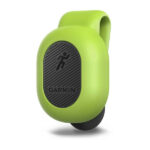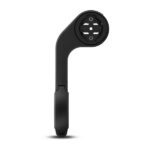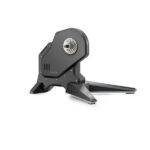Running Dynamic Pod
Original price was: 70,00€.63,00€Current price is: 63,00€. VAT included
- Description
Description
Featherweight detector of running dynamics
- Only 12g lightness
- Clip-on, easy to apply to the back elastic of pants
- Measures all six advanced running dynamics
- Replaces metrics measured by the RUN heart rate monitor
- Battery life of up to 1 year
- Activates automatically on movement
- Connects via Bluetooth® with compatible Garmin device
Why the new Runnin Dynamic Pod
Garmin is offering more and more products that measure heart rate at the wrist with Garmin Elevate™ 2.0 technology, but until now, you had to wear an HRM-Run® heart rate monitor to get the running dynamics data as well. With the new Running Dynamic Pod, you can decide not to wear the belt and still get all the data by simply attaching the pod to the elastic band of your shorts and take your pulse directly to your wrist with a Garmin Elevate-enabled device.
Ground contact time
This is the contact time of the foot with the ground during running. Generally, the ground contact time is very short, so it is measured in milliseconds. The ground contact time tends to be particularly short for the most highly trained athletes, whose times are often less than 200ms. In practice, the ground contact time of all trained athletes is less than 300ms, probably because they have refined their running technique by lifting their feet faster and treading the ground correctly. ‘Overstriding’ describes a running style in which the feet tread the ground too far from the body, slowing movement and generally increasing ground contact times.
Ground contact time balancing
Monitoring the ground contact time (GCT) balance between the left and right foot allows you to measure the symmetry of your run. On Garmin smart sportwatches this is always represented as a percentage above 50 per cent with a left or right arrow to show which foot treads on the ground the longest. For most people, a more symmetrical running style is preferable. Coloured indicators on Garmin watches and on the Garmin Connect™ portal show the balance figure compared to other athletes. Many athletes report that the GCT balance tends to deviate from 50/50 when running uphill or downhill, when doing speed exercises or when tired. In addition, some athletes note that the greater the imbalance, the greater the likelihood of injury.
Cadence
This is the number of steps taken per minute, counting both feet. It is a common running metric that provides a lot of information about the quality of running. For example, at a certain gait, a faster cadence and a shorter stride produce small forces in many parts of the body, e.g. the hips, knees and hips. According to most experts, the low relevance of these forces reduces the risk of injuries and accidents. It is clear that cadence can only increase to a certain point, however for athletes more prone to injury, running with a high cadence can help. An often-cited cadence target is 180 steps per minute, although taller athletes tend to have a lower cadence. Furthermore, it is interesting to note that a higher cadence corresponds to less vertical oscillation and less ground contact time.
stride length
Another key piece of data that measures running style is stride length, i.e. the distance covered by each step, left and right. It is shown at the end of the run as a data field within the activity and can be viewed as you run. You can then view this data in more detail on Garmin Connect™ and see how your stride length changes in relation to your gait, cadence, altitude and other metrics. Your stride length depends on a number of factors, including body morphology, muscle strength and flexibility.
Vertical oscillation
This is the ‘bounce’ you produce with each step of your run. Measured at torso level, it indicates, in centimetres, the distance you run vertically with each step. Many coaches believe that less vertical swing indicates a more efficient running style, as less energy is expended on the vertical movement. Garmin has carried out research on many athletes of all levels. In general, more experienced runners tend to have less vertical oscillation. However, a faster pace corresponds to greater vertical oscillation. The vertical ratio (described below) takes this into account. Another advantage of a reduced vertical swing is that it applies less stress on the lower body at the moment of impact with the ground.
Vertical ratio
This figure is reflected in the efficiency of running in relation to the forward thrust produced with each stride. The vertical ratio is the ‘bounce’ produced in the stride, divided by the stride length and expressed as a percentage. Since the stride length is the horizontal movement of the stride, it is the benefit of the action, while the vertical swing is one of the energy costs of running. A low vertical ratio value indicates a low cost and a high benefit. This means a more efficient ride.












